Sound installation
Sound installation (related to sound art and sound sculpture) is an intermedia and time based art form. It is an expansion of an art installation in the sense that it includes the sound element and therefore the time element.[1] The main difference with a sound sculpture is that a sound installation has a three-dimensional space and the axes with which the different sound objects are being organized are not exclusively internal to the work, but also external. A work of art is an installation only if it makes a dialog with the surrounding space. A sound installation is usually a site-specific but sometimes it can be readapted to other spaces. It can be made either in close or open spaces, and context is fundamental to determine how a sound installation will be aesthetically perceived. The difference between a regular art installation and a sound installation is that the later one has the time element, which gives the visiting public the possibility to stay a longer time due possible curiosity over the development of sound. This temporal factor also gives the audience the excuse to explore the space thoroughly due to the dispositions of the different sounds in space.

Sound installations sometimes use interactive art technology (computers, sensors, mechanical and kinetic devices, etc.) but we also find this type of art form using only sound sources placed in different space points (like speakers), or acoustic music instruments materials like piano strings that are played by a performer or by the public (see Paul Panhuysen). In the context of museums, this combination of interactive technology and multichannel speaker distributions is sometimes referred to as sound scenography.[2]
Sound structure in sound installations
- The simplest sound form is a repeating sound loop. This is mostly used in ambient art, and in this case the sound is not the determinant factor of the art work.
- The most used sound structure is the open form, since the public can decide to experience a sound installation for just a few minutes or for a longer period of time. This obliges the artist to construct a sound organization that is capable of working well in both of the two cases.
- There is also the possibility to have a linear sound structure, where sound develops in the same way as in a musical composition. In this case, the artist might risk not having the audience staying for the whole length of the sound.
Notable sound installation artists
- Miguel Álvarez-Fernández
- Laurie Anderson
- Maryanne Amacher
- Nigel Ayers
- Michael Brewster
- Michael Bach Bachtischa
- Janet Cardiff
- Lawrence Chandler
- Alvin Curran
- Brian Eno
- Bill Fontana
- Terry Fox
- Bernhard Gál
- Joe Jones
- Ryoji Ikeda
- Timo Kahlen
- Jacob Kirkegaard
- Christina Kubisch
- Roland Kuit
- Petri Kuljuntausta
- Augustine Leudar
- Annea Lockwood
- Francisco López
- Alvin Lucier
- Peter Machajdík
- Laura Maes
- Christian Marclay
- Leon Milo
- Robin Minard
- David Monacchi
- Bruce Nauman
- Max Neuhaus
- Carsten Nicolai
- Nam June Paik
- Paul Panhuysen
- Liz Phillips
- Éliane Radigue
- Don Ritter
- Ken Rinaldo
- Manuel Rocha Iturbide
- Stan Shaff
- Laetitia Sonami
- Takis
- Jeff Talman
- Jean Tinguely
- Spencer Topel
- Trimpin
- David Tudor
- Kartz Ucci
- Edwin van der Heide
- Peter Vogel
- Wolf Vostell
- La Monte Young
- Zimoun
See also
Gallery
 Harry Bertoia, Textured Screen, 1954
Harry Bertoia, Textured Screen, 1954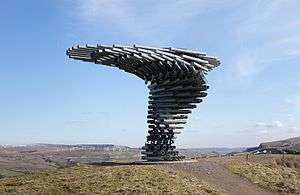
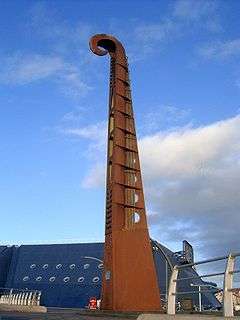
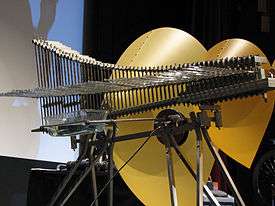 The Cristal Baschet
The Cristal Baschet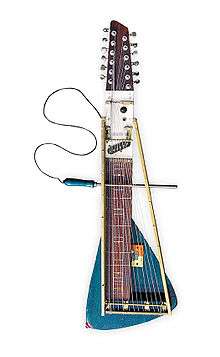 Yuri Landman, Moodswinger, 2006
Yuri Landman, Moodswinger, 2006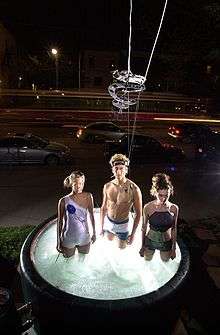
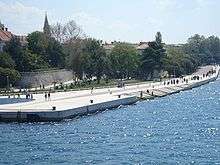 Bašić's sea organ
Bašić's sea organ "Schloss Kapfenburg besaitet..." a sound installation by Renate Hoffleit and Michael Bach Bachtischa, 2000
"Schloss Kapfenburg besaitet..." a sound installation by Renate Hoffleit and Michael Bach Bachtischa, 2000
Further reading
- Fink, Monika (2019). "Sound Sculptures and Sound Installations in the Evolution of Intermedia Art Forms". Music in Art: International Journal for Music Iconography. 44 (1–2): 239–251. ISSN 1522-7464.
References
- Ouzounian, Gascia (2008). Sound art and spatial practices: situating sound installation art since 1958. San Diego: UC.
- Atelier Brückner (2010). Scenography / Szenografie - Making spaces talk / Narrative Räume. Stuttgart: avedition. p. 209.